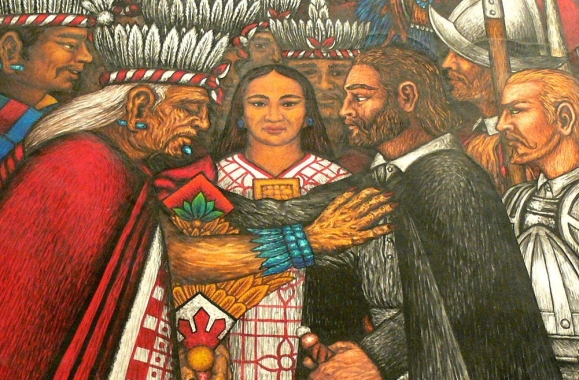Happy Women’s History Month! Let’s dig in… In Mexican history one of the most famous women is a Nahua (Aztec) who lived five hundred years ago. She’s a controversial figure because she rose from slavery to wield power as a diplomat negotiating between two great nations.
She began life named Malinali when she was born around 1500 in what would become the State of Veracruz. You may have heard her called Doña Marina, Malitzin or La Malinche. Her father was a cacique, the leader of the Nahua village Paynalá. After he died when she was young, her mother married another cacique and gave birth to a son. Then Malinali was sold into slavery to the Maya and taken to the area of present day Tabasco. Thus she learned Nahuatl in her birth family and Maya languages as a slave.
Although she was a slave, her intelligence and perceptiveness earned her a place in Mexico’s origin story forever. She was one of twenty young women presented to Cortés as a peace offering by a Maya cacique in Tabasco. All twenty were baptized and given “Christian” names before each was assigned to “cook tortillas” for a specific Spanish man.
After her Spaniard returned to his homeland, Doña Marina (doña is a title of honor because of her noble birth) accompanied Cortés. She swiftly went from his lowly tortilla maker to his interpreter in important meetings. Doña Marina learned Spanish rapidly with her natural linguistic ability. Her counsel and language skills were central to the discussions with Maya and Nahua allies against the emperor. Without her help, Cortés would not have communicated with the Mixteca (Aztec) vassals who helped him defeat Motecuhzoma (Montezuma). According to Cortés, her assistance was indispensable in the overthrow of the Mixteca.
Named Malitzin (-tzin is a nahuatl title of respect) by the indigenous warriors who accompanied Cortés’ forces to the capital city, La Malinche (her nickname in Spanish) has been seen as a traitor to indigenous people. In Mexican Spanish, calling someone La Malinche means they are a Benedict Arnold, a traitor, a turncoat. This term’s significance is central in Mexican culture. According to Spanish sources, before the 1810 Revolution against Spain, Malitzin was seen in a more positive light. In the Revolution, all things Spanish were rejected as foreign dominance and her helping Cortés was demonized.
At her essence, Malitzin is considered the Mexican Eve. She and Cortés had a son, the first mestizo child of Indian and Spanish parents. With her began the new mestizo race of Mexico. Diego Rivera painted a mural of the couple as Adam and Eve in the Mexican Palacio Nacional in the 1930s.
Is La Malinche solely responsible for the collapse of the Mixteca Empire? Is she a villain or a heroine? Was she wrong to help Cortés? What’s your opinion?
Gracias for reading Fake Flamenco. Olé! –Rebecca


Fascinating history lesson Rebecca. I can totally understand why she might be reviled by indigenous communities in Mexico and seen as a traitor. It’s difficult to know her personal motivations for helping the Spaniards in the overthrow of the Mixteca and your question is certainly a good one.
Is it possible that she could have actually thought she was helping her country to progress in some way after seeing the wonders of Spain? Was she just being greedy and selfish wanting to hold on to her favorable status with Cortés? Was she being bullied, controlled and abused into compliance? Would she have been able to look beyond the bloodshed and did she have regrets afterward? Thanks for this introduction to La Malinche!
LikeLiked by 1 person
Thanks for your comments, Henry! She’s quite a controversial figure. As far as I know, she never visited Spain. Tenochtitlán, the Mixteca capital was a marvel unsurpassed by European cities from what I’ve read. The Spaniards had never seen a city like it (somewhat compared by them to Venice). Malinal was given to the Spaniards as a slave. Some think she fell in love with Cortés, but since she was not at liberty to choose how to live her life, I think she simply made her way through a difficult situation with aplomb. Historians also note that there was no pan-Indian movement at the time, so she would not have identified with other Nahuas, since they could be enemy factions. Gracias, Rebecca
LikeLiked by 1 person
she sounds fascinating! I enjoyed this post Rebecca!
LikeLiked by 1 person
Thank you for reading and commenting. I appreciate it very much! R
LikeLiked by 1 person
You’re so welcome Rebecca. XX 😉
LikeLiked by 1 person
Thanks! It would have been so fascinating to meet her. : ) Rebecca
LikeLiked by 1 person
I agree, it would’ve been
LikeLiked by 1 person
Good point that there was no pan-indian sentiments at that time. She was working under a very different world view.
LikeLiked by 1 person
Thanks, Carolyn. That’s a good way to say it.
LikeLike